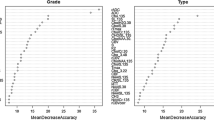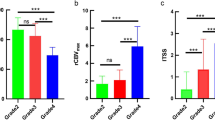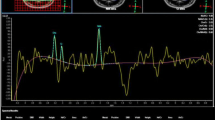Abstract
Introduction
Even low-grade astrocytomas infiltrate the entire brain, a feature that precludes their successful therapy. So to assess the invasive potential of astrocytoma is very important. The aim of this study was determine whether there is a significant correlation between the results of 1H-magnetic resonance spectroscopy (1H-MRS) and tumor invasive potential of astrocytoma, which is reflected by expression of matrix metalloproteinase-2 (MMP-2).
Methods
The 1H-MRS spectra of 41 histologically verified astrocytomas were obtained on a 3-T MR scanner. According to the World Health Organization classification criteria for central nervous system tumors, there were 16 low-grade astrocytomas (2 pilocytic astrocytomas, 14 grade II astrocytomas) and 25 high-grade astrocytomas (5 anaplastic astrocytomas, 20 glioblastomas).The choline/N-acetylaspartate (Cho/NAA) and choline/creatine (Cho/Cr) ratios were calculated. Of the 41 astrocytomas, 19 (8 low-grade and 11 high-grade) were analyzed immunohistochemically. Expression of MMP-2 was determined using streptavidin-peroxidase complex (SP) staining which was quantified by calculating its calibrated opacity density (COD) using an image analysis system. The correlations between metabolite ratios and the quantitative data from the immunohistochemical tests in the 19 astrocytomas were determined.
Results
The Cho/NAA and Cho/Cr ratios of high-grade astrocytoma were both significantly greater than those of low-grade astrocytoma (t = −6.222, P = 0.000; t = −6.533, P = 0.000, respectively). MMP-2 COD values of high-grade astrocytomas were also significantly greater than those of low-grade astrocytomas (t = −5.892, P = 0.000). There were strong positive correlations between Cho/NAA ratio and MMP-2 COD (r = 0.669, P = 0.002), and between Cho/Cr ratio and MMP-2 COD (r = 0.689, P = 0.001).
Conclusion
1H-MRS is helpful in evaluating the invasiveness of astrocytomas and predicting prognosis preoperatively by determining the Cho/NAA and Cho/Cr ratios.




Similar content being viewed by others
References
Rooprai HK, Rucklidge GJ, Panou C, Pilkington GJ (2000) The effects of exogenous growth factors on matrix metalloproteinase secretion by human brain tumour cells. Br J Cancer 82:52–55
Chintala SK, Tonn JC, Rao JS (1999) Matrix metalloproteinases and their biological function in human gliomas. Int J Dev Neurosci 17:495–502
Brinckerhoff CE, Matrisian LM (2002) Matrix metalloproteinases: a tail of a frog that became a prince. Nat Rev Mol Cell Biol 3:207–214
Yong VW, Power C, Forsyth P, Edwards DR (2001) Metalloproteinases in biology and pathology of the nervous system. Nat Rev Neurosci 2:502–511
Lampert K, Machein U, Machein MR, Conca W, Peter HH, Volk B (1998) Expression of matrix metalloproteinases and their tissue inhibitors in human brain tumors. Am J Pathol 153:429–437
Shimizu H, Kumabe T, Shirane R, Yoshimoto T (2000) Correlation between choline level measured by proton MR spectroscopy and Ki-67 labeling index in gliomas. AJNR Am J Neuroradiol 21:659–665
Gupta RK, Cloughesy TF, Sinha U, Garakian J, Lazareff J, Rubino G (2000) Relationships between choline magnetic resonance spectroscopy, apparent diffusion coefficient and quantitative histopathology in human glioma. J Neurooncol 50:215–226
Chen J, Huang SL, Li T, Chen XL (2006) In vivo research in astrocytoma cell proliferation with 1H-magnetic resonance spectroscopy: correlation with histopathology and immunohistochemistry. Neuroradiology 48:312–318
Stadlbauer A, Gruber S, Nimsky C, Fahlbusch R, Hammen T, Buslei R, Tomandl B, Moser E, Ganslandt O (2006) Preoperative grading of gliomas by using metabolite quantification with high-spatial-resolution proton MR spectroscopic imaging. Radiology 238:958–969
Möller-Hartmann W, Herminghaus S, Krings T, Marquardt G, Lanfermann H, Pilatus U, Zanella FE (2002) Clinical application of proton magnetic resonance spectroscopy in the diagnosis of intracranial mass lesions. Neuroradiology 44:371–381
Fountas KN, Kapsalaki EZ, Vogel RL, Fezoulidis I, Robinson JS, Gotsis ED (2004) Noninvasive histologic grading of solid astrocytomas using proton magnetic resonance spectroscopy. Stereotact Funct Neurosurg 82:90–97
Meyerand ME, Pipas JM, Mamourian A, Tosteson TD, Dunn JF (1999) Classification of biopsy-confirmed brain tumors using single-voxel MR spectroscopy. AJNR Am J Neuroradiol 20:117–123
Dowling C, Bollen A, Noworolski SM, McDermott MW, Barbaro NM, Day MR (2001) Preoperative proton MR spectroscopy imaging of brain tumors: correlation with histopathologic analysis of resection specimens. AJNR Am J Neuroradiol 22:604–612
Li X, Jin H, Lu Y, Oh J, Chang S, Nelson SJ (2004) Identification of MRI and 1H MRSI parameters that may predict survival for patients with malignant gliomas. NMR Biomed 17:10–20
Wu WC, Chen CY, Chung HW, Juan CJ, Hsueh CJ, Gao HW (2002) Discrepant MR spectroscopic and perfusion imaging results in a case of malignant transformation of cerebral glioma. AJNR Am J Neuroradiol 23:1775–1778
Hu B, Guo P, Fang Q, Tao HQ, Wang D, Nagane M, Huang HJ, Gunji Y, Nishikawa R, Alitalo K, Cavenee WK, Cheng SY (2003) Angiopoietin-2 induces human glioma invasion through the activation of matrix metalloprotease-2. Proc Natl Acad Sci U S A 100:8904–8909
Takahashi M, Fukami S, Iwata N, Inoue K, Itohara S, Itoh H (2002) In vivo, glioma growth requires host derived matrix metalloproteinase 2 for maintenance of angioarchitecture. Pharmacol Res 46:155–163
Nafe R, Herminghaus S, Raab P, Wagner S, Pilatus U, Schneider B (2003) Preoperative proton-MR spectroscopy of gliomas – correlation with quantitative nuclear morphology in surgical specimen. J Neurooncol 63:233–245
Conflict of interest statement
We declare that we have no conflict of interest.
Author information
Authors and Affiliations
Corresponding author
Rights and permissions
About this article
Cite this article
Zhang, K., Li, C., Liu, Y. et al. Evaluation of invasiveness of astrocytoma using 1H-magnetic resonance spectroscopy: correlation with expression of matrix metalloproteinase-2. Neuroradiology 49, 913–919 (2007). https://doi.org/10.1007/s00234-007-0271-8
Received:
Accepted:
Published:
Issue Date:
DOI: https://doi.org/10.1007/s00234-007-0271-8




